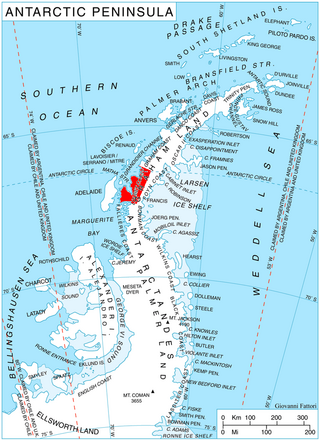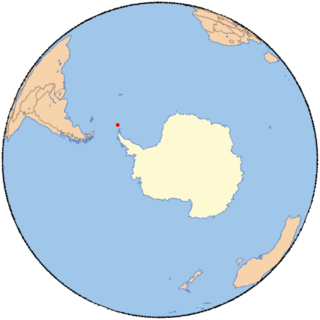
Thurston Island is a largely ice-covered, glacially dissected island, 135 nautical miles long and 55 nautical miles wide, lying between Amundsen Sea and Bellingshausen Sea a short way off the northwest end of Ellsworth Land, Antarctica. The island is separated from the mainland by Peacock Sound, which is occupied by the west portion of Abbot Ice Shelf.

The Prince Charles Mountains are a major group of mountains in Mac. Robertson Land in Antarctica, including the Athos Range, the Porthos Range, and the Aramis Range. The highest peak is Mount Menzies, with a height of 3,228 m (10,591 ft). Other prominent peaks are Mount Izabelle and Mount Stinear. These mountains, together with other scattered peaks, form an arc about 420 km (260 mi) long, extending from the vicinity of Mount Starlight in the north to Goodspeed Nunataks in the south.
Mill Inlet is an ice-filled inlet which recedes 8 nautical miles (15 km) in a northwesterly direction and is some 20 nautical miles (37 km) wide at its entrance between Cape Robinson and Monnier Point, along the east coast of Graham Land, Antarctica. It was charted by the Falkland Islands Dependencies Survey in 1947 and named for Hugh Robert Mill. It was photographed from the air during 1947 by the Ronne Antarctic Research Expedition under Finn Ronne.

Aagaard Glacier, also known as Glaciar Alderete, is an 8-mile (13 km) long Antarctic glacier which lies close to the east of Gould Glacier and flows in a southerly direction into Mill Inlet, on the east coast of Graham Land. It was charted by the Falkland Islands Dependencies Survey (FIDS) and photographed from the air by the Ronne Antarctic Research Expedition during December 1947; it was named by the FIDS for Bjarne Aagaard, a Norwegian authority on Antarctic whaling and exploration.
Exasperation Inlet is a large ice-filled inlet, 16 miles (26 km) wide at its entrance between Foyn Point and Cape Disappointment, on the east coast of Graham Land. It was charted in 1947 by the Falkland Islands Dependencies Survey, who so named it because the disturbed nature of the ice in the vicinity caused considerable difficulty to sledging parties.

Foyn Point is a point surmounted by a peak 525 metres (1,720 ft) high, forming the southeast extremity of Blagoevgrad Peninsula and marking the north side of the entrance to Exasperation Inlet, on Oscar II Coast on the east side of Graham Land, Antarctica. Sir Hubert Wilkins on a flight of December 20, 1928 photographed what appeared to be an island off the east coast, later charting it in 66°30′S62°30′W. Subsequent comparison of Wilkins' photographs of this feature with those taken by the Falkland Islands Dependencies Survey, who charted the coast in 1947, indicate that this point, although considerably north of the position reported by Wilkins, is the feature named by him as "Foyn Island". The name Foyn Point is given to the southeast extremity of this feature. It is named for Svend Foyn.

Avery Plateau is an ice-covered plateau, about 40 miles (64 km) long and rising to about 2,000 metres (6,600 ft), midway between Loubet Coast and Foyn Coast in Graham Land, Antarctica. It borders the Hemimont Plateau on the south and the Bruce Plateau on the north. The first sighting of this plateau is still being determined. Still, it was presumably seen in January and February 1909 by members of the French Antarctic Expedition under Jean-Baptiste Charcot from various positions in the Matha Strait. It was surveyed in 1946–47 by the Falkland Islands Dependencies Survey and named by the UK Antarctic Place-Names Committee (1955) after Captain George Avery, master of the cutter Lively, who, with Captain John Biscoe in the brig Tula, approached this part of the Antarctic Peninsula in February 1832.

Breitfuss Glacier is a glacier 10 nautical miles (19 km) long, which flows southeast from Avery Plateau into Mill Inlet to the west of Cape Chavanne, on the east coast of Graham Land. It was charted by the Falkland Islands Dependencies Survey (FIDS) and photographed from the air by the Ronne Antarctic Research Expedition in 1947. It was named by the FIDS for Leonid Breitfuss, a German polar explorer, historian, and author of many polar bibliographies.
The Douglas Islands are two small islands 22 kilometres (12 nmi) northwest of Cape Daly, and 6 kilometres (3 nmi) north of Andersen Island, as well as 7 kilometres (4 nmi) north-east of Child Rocks, which are both part of the Robinson Group. The islands lie off the coast of Mac. Robertson Land in Antarctica.

Drummond Glacier is a glacier 10 nautical miles (18 km) long and 2 nautical miles (4 km) wide, on the west coast of Graham Land, situated south of Hopkins Glacier and flowing west-northwest between Voit Peak and Sherba Ridge into Darbel Bay east of Sokol Point.
Erskine Glacier is a glacier 16 nautical miles (30 km) long on the west coast of Graham Land, flowing west into Darbel Bay to the north of Hopkins Glacier. It was first surveyed by the Falkland Islands Dependencies Survey (FIDS) in 1946–47, and named "West Gould Glacier". With East Gould Glacier it was reported to fill a transverse depression across Graham Land, but further survey in 1957 showed no close topographical alignment between the two. The name Gould has been limited to the east glacier and an entirely new name, for Angus B. Erskine, leader of the first FIDS party to travel down the glacier and to survey it in detail, has been approved for the west glacier.
Evans Piedmont Glacier is a broad ice sheet occupying the low-lying coastal platform between Tripp Island and Cape Archer in Victoria Land, Antarctica.

Cape Garcia is a cape at the north side of the entrance to Barilari Bay, forming the north extremity of Felipe Solo (Obligado) Peninsula on the west coast of Graham Land, Antarctica. The cape was discovered and named "Cap Loqui" by the French Antarctic Expedition, 1903–05, under Jean-Baptiste Charcot. At the same time Charcot named the south entrance point to the bay "Cap Garcia," after Rear Admiral Garcia of the Argentine Navy. The maps of Charcot's French Antarctic Expedition, 1908–10, showed "Cap Garcia" as the north cape of Barilari Bay and the name has since become established for this feature. Charcot did not use the name "Cap Loqui" on the maps of his second expedition but, for the sake of historical continuity, the name Loqui Point has been accepted for the south entrance point.
Cape Hansen is a cape which separates Marshall Bay and Iceberg Bay on the south coast of Coronation Island, in the South Orkney Islands, Antarctica. The name appears on a chart based upon a running survey of the islands in 1912–13 by Petter Sørlle, a Norwegian whaling captain.

Southard Promontory is a notable promontory, 6 nautical miles long and 2 nautical miles wide, which juts into northwest Mill Inlet between Breitfuss Glacier and Alberts Glacier, on the Foyn Coast, Graham Land. The promontory is bordered by steep rock cliffs which rise 1,500 metres (4,900 ft) to a relatively flat and snow covered upper surface. It was photographed from the air by Ronne Antarctic Research Expedition (RARE) and surveyed from the ground by Falkland Islands Dependencies Survey (FIDS) in 1947. In association with the names of Antarctic cartographers grouped in this area, named by the United Kingdom Antarctic Place-Names Committee (UK-APC) after Rupert B. Southard, Jr., Chief, National Mapping Division, United States Geological Survey (USGS), 1979–86; Chief, Office of International Activities, 1961–64; U.S. Representative to the SCAR Working Group on Geodesy and Cartography, 1964–79; Chairman, Domestic Names Committee of the USBGN, 1983-87.

Cape Vik is a cape marking the west side of the entrance to Marshall Bay on the south coast of Coronation Island, in the South Orkney Islands. The cape appears to be first shown and named on a chart made by the Norwegian whaler Captain Petter Sorlle in 1912–13.

Cape Robinson is a cape marking the east end of Cole Peninsula, between Cabinet and Mill Inlets on Foyn Coast, Graham Land. Sir Hubert Wilkins, while on his flight of December 20, 1928 along this coast, named an island for W.S. Robinson of London and Australia, which he reported to lie in about 67°20′S61°40′W. Absence of photographs of this island by Wilkins has prevented its positive reidentification. For this reason, and for the sake of historical continuity, it is recommended that the east end of the peninsula here described be given the name Cape Robinson. This cape was charted by the Falkland Islands Dependencies Survey (FIDS) and photographed from the air by the Ronne Antarctic Research Expedition (RARE) in 1947.

Roscoe Promontory is a massive ice-capped promontory between Aagaard Glacier and Mitterling Glacier on the north side of Mill Inlet, Foyn Coast, Graham Land. The feature was photographed by Ronne Antarctic Research Expedition (RARE) and surveyed by Falkland Islands Dependencies Survey (FIDS) in 1947. Named by Advisory Committee on Antarctic Names (US-ACAN) in 1987 after John H. Roscoe, photogrammetrist on U.S. Navy Operation Highjump, 1946–47, and Operation Windmill, 1947–48; author of Antarctic Bibliography, U.S. Naval Photographic Interpretation Center, Department of the Navy, 1951, and Antarctica, Regional Photo Interpretation Series, Department of the Air Force, 1953. The promontory is in proximity to several features named after Antarctic bibliographers.

Mount Odin is a saddle-top mountain on the Foyn Coast of Graham Land, Antarctica. It consists of two ice-covered peaks and stands 1,465 m (4,806 ft) tall. It is situated close to Frigga Peak to the southwest, on the divide between Anderson Glacier and Sleipnir Glacier. In 1947, the peak was photographed from the air by the Ronne Antarctic Research Expedition (RARE) and charted from the ground by the Falklands Islands Dependencies Survey (FIDS). It was named by FIDS personnel after the Norse god Odin, the mythological husband of Frigga.
This is a list of rock formations in the French Antarctic territory of Adélie Land.








